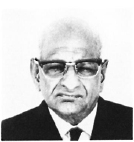- Volume 59 , Number 3
- Page: 494–5
Dharmendra, M.B.B.S., Dip. Bact. (London) 1900-1991

Dharmendra was born on 1 February 1900. He graduated in medicine from the King Edward Medical College, Lahore, India, in 1928. He had a distinguished career as a student. He had discontinued his studies for 2 years as a protest against the Jallianwala Baug massacre and joined the noncooperation movement launched by Mahatma Gandhi.
He joined the School of Tropical Medicine in Calcutta as an Assistant Research Officer of the erstwhile Indian Research Fund Association (now the Indian Council of Medical Research) in 1928. There he found that senior workers engaged in leprosy research were all foreigners. Therefore, leprosy research offerred a challenge to him, which he took up against the wishes of his family. The stigma which was attached to leprosy patients was also attached, to some extent, to doctors working in leprosy. He derived help from Dr. Lowe, who was at that time head of the department.
During those early days at the Indian Research Fund Association, a leprosy researcher's work encompassed several disciplines, such as clinical, epidemiological and bioscientific. Dr. Dharmendra's name is associated with all of these disciplines in which research was carried out at this center. He is especialy known for the chloroform and ether extraction of Mycobacterium leprae from human lepromatous tissue and the use of the bacillary suspension, called Dharmendra lepromin, for skin testing. As early as 1941, he had observed that the positive response evoked by Dharmendra lepromin was due to its protein content.
While about to retire in 1955, he was asked by the Government of India to head the National Leprosy Control Programme as its first director. There he laid the foundation for one of the most successful health programs of the country.
In 1957, he was assigned the task of organizing the pioneering institute exclusively devoted to leprosy research and teaching in Chengalpattu. He collected together a band of young medical men and groomed them into productive scientists. The investigation of the effect of dapsone prophylaxis in preventing leprosy among the contacts of lepromatous patients is a fine example of his planning of a scientific experiment with the population as the laboratory.
In 1967, he retired from the post of Director, Central Leprosy Teaching and Research Institute, but continued to work there as an emeritus scientist of the Indian Council of Medical Research until 1970. He received the prestigious Damien-Dutton Award in 1970.
He was a founding member of the Indian Association of Leprologists and was its president for four terms. Dr. Dharmendra had been the Editor of the quarterly scientific journal "Leprosy in India," later renamed "Indian Journal of Leprosy," more or less continuously from 1929 to 1989, with breaks for two short periods. It was his persuasive efforts that have led to a continuous flow of scientific articles from medical and nonmedical Indian scientists. He authored the textbook Notes on Leprosy in 1960, and brought out a revised edition in 1967. Its popularity among leprosy workers led him to edit the monumental work Leprosy, the first volume of which was published in 1978, the second in 1985.
Dr. Dharmendra was revered as an authority on all aspects of leprosy, and his advice was sought by many. Consequently, he was a member of several committees set up by the Government of India, Indian Council of Medical Research and the Hind Kusht Nivaran Sangh. The Government of India honored him by conferring Padma Shri. He was on the advisory panel of the World Health Organization, and had been a member of some of the expert committees. The International Gandhi Award was presented to him in 1986.
His austere life and outlook gave him a rough exterior behind which was a person full of compassion for the patients and workers alike. Dr. Dharmendra owed the placid course of his long life in no small measure to the loving care of his devoted wife.
With the passing away of Dr. Dharmendra on 10 March 1991, the world of leprosy lost one of its original stalwarts. We share this moment of pain with his family and Mrs. Dharmendra, whose affection and hospitality many will remember.
- Gopal Ramu, M.D.